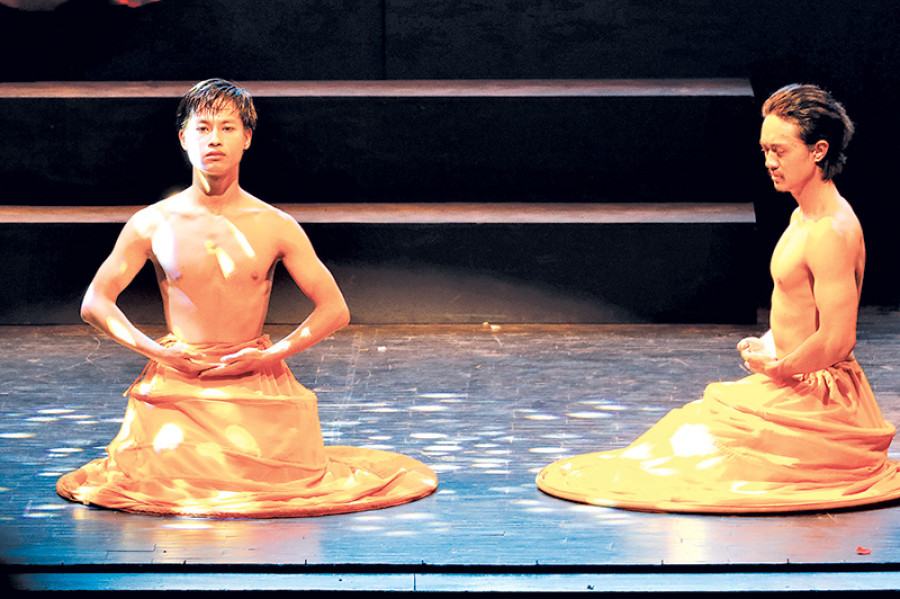Miscellaneous
Form without substance
Curious theatre goers: there is good news and there is bad news. The good news is that there is an ongoing stage production whose production value will fill you with awe, excitement, and wonder. The bad news is the production does not have the depth that one expects out of a theatre production.
Sandesh Ghimire
Curious theatre goers: there is good news and there is bad news. The good news is that there is an ongoing stage production whose production value will fill you with awe, excitement, and wonder. The bad news is the production does not have the depth that one expects out of a theatre production.
Bodhi Chhaaya, which premiered at the Rastriya Naach Ghar in the Capital this week, brings together many Nepali dance forms, both traditional and contemporary, to tell the all-too-familiar text-book story of a young prince who left the pleasures of life to become the awakened one: the life of the Buddha. The dances are varied and incorporate many established dance routines of several ethnicities. This brings to stage the oft-repeated adage about Nepal: This country is a garden of numerous cultures. The shadow-work, the animation on screen, the Thanka and contemporary paintings, amazing choreography, stunning costumes and heartfelt music greatly contribute to the cultural presentation of Nepal. A massive collaborative effort, with involvement of around 100 artists and crew, Bodhi Chhaaya is an extravagance that is unprecedented in the Nepali theatre scene—on a scale seldom before attempted.
The story follows the well-known tale of Buddha’s life: Early in his youth, Siddhartha senses that pleasures of life wither like flowers in a field and a spiritual hunger drives the young prince out of his palace gate. Like Siddhartha, we are aware that most of life escapes our senses, and we go to the theatre with a hope that the performance will make the invisible currents of life visible. So what better subject matter is there to explore the underpinnings of human life than the life of the Buddha? In Bodi Chhaaya, there are moments where the performance on stage makes Siddhartha’s private struggles public, and we too start yearning for liberation, for Moksha, but these moments are fleeting, disjointed, and often a bland voice-over narration is used to present the inner tussle. Using riveting Nepali dance sequels, all of which are thoughtfully crafted and placed, Bodhi Chhaaya manages to weave the life events of the awakened one, but the play barely scratches the surface of Siddhartha’s spiritual strivings.

The production’s objective is clear: to bring together diverse Nepali traditions on to the stage, which the production triumphantly manages to achieve. The play could have chosen an entirely different theme, say the Anglo-Nepali war, and still manage to successfully achieve its objective. But, by choosing Buddha’s life as the theme and presenting the story with grandeur, the play dilutes the moral underpinning and seriousness of the choices that Siddhartha made during his lifetime—the constant hooting by the audience members throughout the play shows that they were captivated by the stylistic grandeur rather than the story. In other words, Buddha deserves a theatre of silence rather than one of musical explosion.
Despite the flaw, however, Bodhi Chhaaya is a visual treat, and its technical superiority easily dwarves the production value of any other play that came before it. The organisers plan to keep the play on stage every day for the next five years, and their hope is that the play will become a part of to-do list for every foreigner that visits Kathmandu. The play could function as a living museum for Nepali cultural heritage, but since Bodhi Chhaaya brings together dances from so many cultures onto a single stage, one does wonder if the production has done justice to its sources. However, it is too early to say whether the production is promoting Nepali diversity or further feeding western stereotypes.

There is no denying that the artist works out of a necessity, but if the work does not create the same thirst in the mind of the audience, and delivers only a wow-factor, as Bodhi does, then theatre will always be considered an extension of our social fabric. And, as long as theatre is taken as an extension, it will remain a dispensable part of life—thus making it a leisurely activity for the privileged few. In the book The Empty Space, Peter Brooks writes that when the barrier between the audience and actors is broken, and if we start entertaining the idea that the difference between the audience and the artist is a practical difference, not a fundamental one then theatre will become an indispensable part of everybody’s life. When the obstacle between audience and artist is removed, ambitious Nepali production will not have to rely on international crowd to remain financially afloat.




 18.12°C Kathmandu
18.12°C Kathmandu










